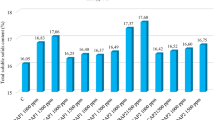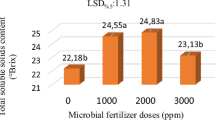Abstract
Bioactive compounds and electrochemical characteristics are remarkable quality components for wine grapes and quality characteristics of grape are influenced by various factors such as grape cultivar, environmental and viticultural practices in a vineyard. There has recently been growing interest in improvement of wine grape quality characteristics by means of basal leaf removal (BLR) and reflective mulch (RM) practices. In current study, treatments of BLR, RM and BLR + RM were performed at two different phenological stages of grapevine, including pea size period (PSP) and vérasion period (VP). At the end of research, study results revealed that different treatment timings of basal leaf removal and reflective mulch had crucial roles on increasing of wine grape quality. Consequently, BLR-PSP + RM-PSP treatment especially led to significant enhancements in biochemical characteristics of cv. Cabernet Sauvignon like phenolic compounds, anthocyanins and electrochemical characteristics.







Similar content being viewed by others
References
Barnuud NN, Zerihun A, Gebberd M, Bates B (2014) Berry composition and climate: responses and empirical models. Int J Biometeorol 58(6):1207–1122
Brar HS, Singh Z, Swinny E (2008) Dynamics of anthocyanin and flavonol profiles in the ‘Crimson Seedless’ grape berry during development and ripening. Sci Hortic 117(4):349–356
Brighenti E, Casagrande K, Cardoso PZ, Pasa MS, Ciotta MN, Brighenti AF (2017) Total polyphenols contents in different grapevine varieties in highlands of Southern Brazil. In: 40th World Congress of Vine and Wine: 29 May–02 June, Sofia, Bulgaria, pp 1–5
Coombe BG, Dundron RJ, Short AWS (1980) Indices of sugar-acidity as ripeness criteria for wine grapes. J Sci Food Agric 31(5):495–502
Cozzolino D, Cynkar W, Janik L, Dambergs RG, Gishen M (2006) Analysis of grape and wine by near infrared spectroscopy—A review. J Near Infrared Spectrosc 14(5):279–289
Cristea E (2014) Determination of the optimal phenolic extraction yield in red wines using the Glories Method. Master Thesis, Escola Superior de Biotecnologia of the Universidade Católica, Portuguesa, 61p
Diago MP, Vilanova M, Tardaguila J (2010) Effects of timing of manual and mechanical early defoliation on the aroma of Vitis vinifera L. Tempranillo wine. Am J Enol Vitic 61:382–391
Dokoozlian NK, Kliewer WM (1995) The light environment within grapevine canopies. II. Influence of leaf area density on fruit zone light environment and some canopy assessment parameters. Am J Enol Vitic 46(2):219–226
Ergun M (2012) Efficacy and inefficacy of refrigerated storages on some physical, physiochemical and electrochemical properties for organically-grown ‘Royal Glory’ and ‘Redhaven’ peaches. J Appl Bot Food Qual 85(1):79–85
Ergun M (2017) Physical, physiochemical and electrochemical responses of ‘Galaxy’ apples to mild bruising. Eur J Hortic Sci 82(5):244–250
Fraga H, Malheiro AC, Moutinho-Pereiram J, Santos A (2013) Future scenarios for viticultural zoning in Europe: ensemble projections and uncertainties. Int J Biometeorol 57(6):909–925
Gishen M, Dambergs RG, Cozzolino D (2005) Grape and wine analysis-enhancing the power of spectroscopy with chemometrics. A review of some applications in the Australian wine industry. Aust J Grape Wine Res 11(3):296–305
Goldammer T (2018) Grape grower’s handbook, 3rd edn. Apex, , p 482
Guerra B, Steenwerth K (2012) Influence of floor management technique on grapevine growth, disease pressure and juice and wine composition: a review. Am J Enol Vitic 63(2):149–164
Hoffmann M (1991) Elektrochemische Merkmale zur Differenzierung von Lebensmitteln. In: Meier-Ploeger A, Vogtmann H (eds) Lebensmittelqualität – Ganzheitliche Methoden und Konzepte. Alternative Konzepte, vol 66. Deukalion, Karlsruhe, pp 67–86
Hostetler GL, Merwin IA, Brown MG, Padilla-Zakour O (2007a) Influence of undervine floor management on weed competition, vine nutrition and yields of Pinot Noir. Am J Enol Vitic 58(4):421–430
Hostetler GL, Merwin IA, Brown MG, Padilla-Zakour O (2007b) Influence of geotextile mulches on canopy microclimate, yield and fruit composition of Cabernet Franc. Am J Enol Vitic 58(4):431–442
Howell GS, Miller DP, Edson CE, Striegler RK (1991) Influence of training system and pruning severity on yield, vine size and fruit composition of Vignoles grapevines. Am J Enol Vitic 42(3):191–198
Keller M (2015) The science of grapevines, 2nd edn. Academic Press, New York, Boston, London, Oxford, p 522
Kok D (2014) A review on grape growing in tropical regions. Turk J Agric Nat Sci Spec Issue 1:1236–1241
Kok D (2017) Assessment of electrochemical attribute and monoterpene content of twelve aromatic grape cultivars (V. vinifera L.) grown under the ecological conditions of Northwestern Turkey. Oxid Commun 40(1-II):557–564
Kok D, Bal E (2017a) Compositional differences in phenolic compounds and anthocyanin contents of some table and wine grape (Vitis vinifera L.) varieties from Turkey. Oxid Commun 40(2):648–656
Kok D, Bal E (2017b) Electrochemical properties and biochemical composition of cv. Shiraz wine grape (V. vinifera L.) depending on various dose and application time of foliar microbial fertilizer treatments. Erwerbs-Obstbau 59(4):263–268
Lamikanra O, Inyang I, Leong S (1995) Distribution and effect of grape maturity on organic acid content of red Muscadine grapes. J Agric Food Chem 43(1):3026–3028
Lee J, Skinkis PA (2013) Oregon ‘Pinot Noir’ grape anthocyanin enhancement by early leaf removal. Food Chem 139(1–4):893–901
Lemut MS, Trost K, Sivilotti P, Vrhovsek U (2011) Pinot Noir grape colour related phenolics as affected by leaf removal treatments in the Vipava Valley. J Food Compost Anal 24(6):777–784
Osrecak M, Karoglan M, Kozina B, Preiner D (2015) Influence of leaf removal and reflective mulch on phenolic composition of white wines. J Int Sci Vigne Vin 49(3):183–193
Osrecak M, Karoglan M, Kozina B (2016) Influence of leaf removal and reflective mulch on phenolic composition and antioxidant activity of Merlot, Teran and Plavac Mali wines (Vitis vinifera L.). Sci Hortic 209:261–269
Percival DC, Fisher KH, Sullivan JA (1994) Use of fruit zone leaf removal with Vitis vinifera L. cv. Riesling grapevines. II. Effect on fruit composition, yield and occurrence of bunch rot (Botrytis cinerea Pers.: Fr). Am J Enol Vitic 45(2):133–140
Razungles A, Baumes R, Robin JP, Bayonove C (1996) Microclimatic influences in the vineyard on the flavor quality of grapes. In: Proceedings of the 4th International Symposium on Cool Climate Viticulture and Enology: 16 July–20 July 1996, New York, USA, pp 49–53
Reynolds AG, Pearson EG, De Savigny C, Conventry J, Strommer J (2008) Interactions of vine age and reflective mulch upon berry, must and wine composition of five Vitis vinifera cultivars. Int J Fruit Sci 7(4):85–119
Ribereau-Gayon P, Glories Y, Maujean A, Dubourdieu D (2001) Handbook of enology: the chemistry of wine stabilization and treatments vol 2. John Wiley & Sons Ltd, Chichester, p 451
Robinson J, Harding J (2015) The Oxford companion to wine. Oxford University Press, Oxford, p 860
Singleton VL, Timberlake CF, Kea L (1978) The phenolic cinnamates of white grapes and wine. J Sci Food Agric 29(4):403–410
Sluys SL (2006) Climatic influences on the grapevine: A study of viticulture in the Waipara basin. Master of Science, University of Canterbury, New Zealand, 112p
Smart R, Robinson M (1991) Sunlight into wine. A handbook for wine grape canopy management, p 88 (Ministry of Agriculture and Fisheries, New Zealand)
Smithyman RP, Howell GS, Miller DP (1997) Influence of canopy configuration on vegetative development, yield and fruit composition of ‘Seyval Blanc’ grapevines. Am J Enol Vitic 48(4):482–491
Sonnekus N (2015) Development and change that occur in table grape berry composition during growth, p 103 (Master of Agriculture Science, Stellenbosch University, South Africa)
Di Stefano R, Cravero MC (1991) Metodi Per lo studio dei polifenoli dell’uva. Riv Vitic Enol 44(2):37–45
Wolf G, Rey C (1997) Wie Qualität elektrochemisch zu messen ist. In: Hoffmann M (ed) Vom Lebendigen in Lebensmitteln. Deukalion, Holm, pp 50–60
Zoecklein BW (2010) Managing wine quality. In: Reynolds AG (ed) Practical methods of measuring grape quality. Viticulture and wine quality, vol 1. CRC Press, Boca Raton, pp 107–133
Author information
Authors and Affiliations
Corresponding author
Ethics declarations
Conflict of interest
D. Kok declares that he has no competing interests.
Rights and permissions
About this article
Cite this article
Kok, D. Different Treatment Timings of Basal Leaf Removal and Reflective Mulch Affect Biochemical and Electrochemical Characteristics of cv. Cabernet Sauvignon Wine Grapes (V. vinifera L.). Erwerbs-Obstbau 63 (Suppl 1), 23–30 (2021). https://doi.org/10.1007/s10341-021-00576-4
Received:
Accepted:
Published:
Issue Date:
DOI: https://doi.org/10.1007/s10341-021-00576-4
Keywords
- Wine grape
- Basal leaf removal
- Reflective mulch
- Electrochemical quality parameter
- Biochemical characteristics




